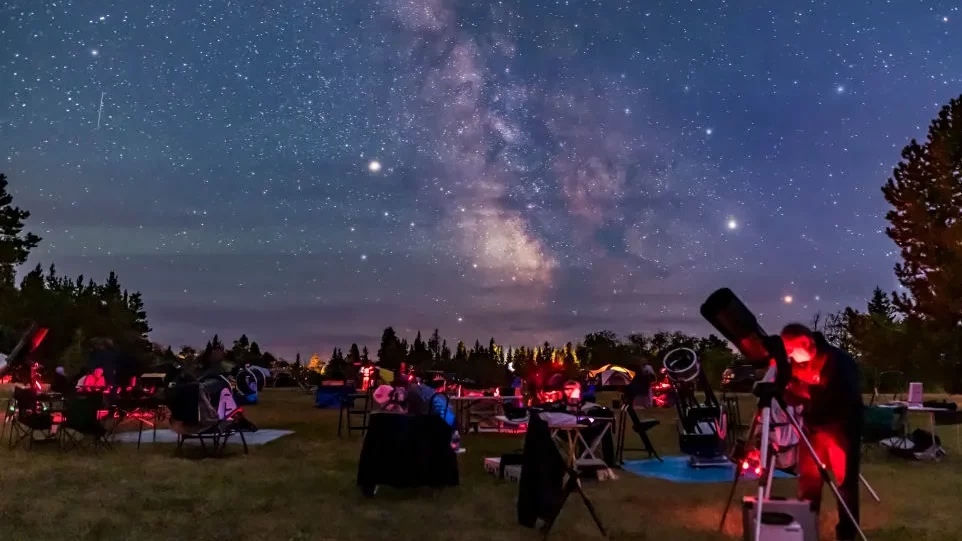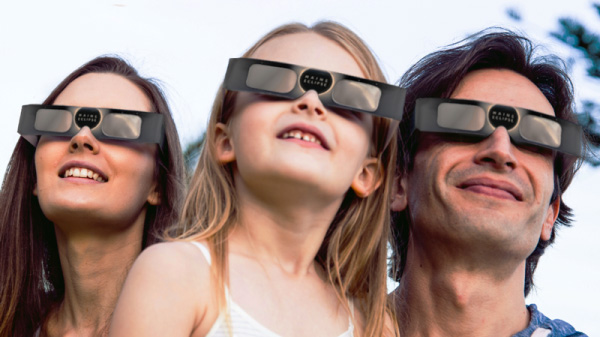What to consider and look for in “Jumbo” binoculars
Astronomy binoculars for gazing at the night sky are a specialty optic, often a first step for budding amateur astronomers who don’t want to commit to investing in the cost and time required to learn how to operate a telescope. They jokingly say two eyes (lens) are better than one (in a telescope). These jumbo binoculars let you see small things far away without a telescope. Astronomy binoculars are heavy to hold and require a tripod for viewing. Popular sizes are in the range of 20×70 to 25 x100 and some include solar filters. Here is how to choose and what features to consider for stargazing binoculars.
A diehard amateur astronomer with a telescope probably won’t agree but looking skyward with one of these jumbo bad boys you’ll see some pretty amazing celestial stuff. If you’re lured to the night sky, you’ll learn they range in price upwards of $200 and require a sturdy tripod (about $100). The tripod is essential because the optics are heavy and you can’t hold them steady. You’ll find some of the large glasses sold with a tripod as a package in the $150 range. You’ll find others sold as kits with solar filters installed for around $300.

The jumbo package we use
We have 20×80 giant binos (just under $200) with a sturdy old tripod we’ve used for photography for many years. These large binos come with a built-in adjustable bracket for easy attachment to the tripod. We added a plastic bracket to the front of the binoculars to hold a Red Dot finder. This setup gives us a good view of the night sky at a reasonable price.
High powered binoculars have a narrow field of view so once the Red Dot finder is adjusted we just point the binoculars in the general direction of our target and then look for the target through the Red Dot which has a much wider field of view. When the Red Dot is on the target, we then look through the binos, and sure enough it’s there.
The view from binoculars with stargazing in mind
On a clear night what you’ll see from these jumbo binos is amazing. For example, moon watchers can become spellbound looking at the craters and lakes on the surface. Follow the changes of the moon beginning at new moon until it waxes and wanes through its phases.
With the weight of these bad boys mounted on a tripod you’ll become mesmerized by the detail of the moon maria or grey-like globs and blotches on the surface. You’ll see large star clusters totally hidden from view by your naked eye.
Get the app Stellarium and become familiar using it to locate planets orbiting around the sun close to earth. You’ll get hooked on the wonder of the night sky.
What the numbers mean

In this field of stargazing optics popular sizes are 25×70, 25×100, 20×80 and 15×63 for larger binoculars. Other sizes that are easier to hand hold range from 7×24 to 8×50 .
A pair of binoculars marked 8x42mm magnifies 8 times and has an objective lens of 42 mm in diameter. Another way to describe the numbers are the first number 8 means the object is magnified about 8 times. The second number describes the diameter or light gathering ability of the objective lens in millimeters.

The larger the objective lens the fainter the object you can see. Experts tell us magnification of 7 to 8 times is optimum for hand-held use so definitely include a tripod if you’re considering one of these larger binoculars.
TIP Our firsthand experience using binoculars stargazing: Don’t go stargazing without these 3 items: 1. For a steady supported view, use a tripod that’s lightweight and easy to assemble 2. To find your way around a group of stargazers in the dark, use a small mini red flashlight instead of a white light that interferes with night vision. A red light head lamp is also a good idea. 3. Get a red dot finder (RDF) to pinpoint a star or object. It superimposes a small red dot on the sky where you’re looking. Tripod, Red Light, RDF repeat.
Features of binoculars for stargazing

A prism or Porro prism has the objective lens and eyepiece offset and most large binoculars use this design. Many great binoculars in the 7×42 or 8×42 range have plenty of light gathering ability. These binoculars usually have Roof prisms which allow for a more streamlined inline barrel designed.
Other Features
- Look for binos with an anti-reflection coating. Read the binocular’s specifications. Don’t consider binoculars without coated lenses. Multicoated lenses are the best and transmit light most efficiently. Skip binoculars with colored coatings.
- If you wear glasses pay attention to the full view you see through the binoculars. Check that you can see the total object you are looking at with your eyeglasses on.
- Do the binos keep the object in focus not only in the center of the viewing field, but to the edges of the view? They should.
- Check if the barrels are aligned by focusing on an object. Then open and closs your eyes to see if the image you’re seeing remains stable. In lower priced binos you may see double images or slight rainbow-like colors. Neither is a good thing.
More useful accessories for stargazing
A tripod is a mount that stabilizes the view providing a steady image. A tripod is also useful for mounting a spotting scope and camera equipment for more accurate shooting.
Using a tripod adapter allows you to attach a pair of standard binoculars to a tripod. After you unscrew the name plate from the front of the binocular center post, the adapter screws into the opening. These 16×50 binoculars mounted on a tripod makes a good setup for looking at the moon and planets. The tripod mount makes much steadier image possible and a lot easier on the arms.

A simple cell phone adapter holds the camera in the phone over the binoculars eye piece so you can take pictures or record video of what you are looking at through the binoculars.

For large binoculars mounted on a tripod we think a Red Dot finder is a good investment for less than $50. The Red Dot finder has an unmagnified view like a gun sight that lets you find a target by putting the dot on the object. All you have to do is sharpen the focus.

A Parallelogram for less than $200 is a mount that fits on a tripod and lets you move jumbo binoculars around and adjust the direction while staying on a fixed target. You can change its view and orientation without disturbing the image. You’ll see they often have a counterweight to balance the binoculars and an adapter to attach to any binoculars with a tripod adjuster.

- A Lot to Know about Astronomy Crossword Puzzle
- Choosing Binoculars for Kids
- Choosing Binoculars for Boating
- Stars at Home and Backyard Stargazing
Gene and Katie Hamilton are amateur astronomers who follow the stars and write about their dark sky adventures. They are members of the Outdoor Writers Association of America.
Post Views: 3,575
|













